Are Companies Over Managed and Under Led? A Leadership Study
VerifiedAdded on 2021/06/15
|8
|1999
|10
Essay
AI Summary
This essay critically examines the contemporary debate surrounding over-management and under-leading in organizations, emphasizing the crucial distinction between management and leadership. It introduces the path-goal theory of leadership, highlighting its four styles: directive, supportive, participative, and achievement-oriented. The essay explores how these styles can address the issue of over-management by fostering employee motivation and creating a culture of trust and transparency. It discusses the importance of adapting leadership styles to different cultural contexts and the need for leaders to understand the nuances of data collection and information gathering. Ultimately, the paper argues for a shift towards more flexible and open organizational cultures that bridge the gap between managers and charismatic leaders to overcome the challenges of globalization.
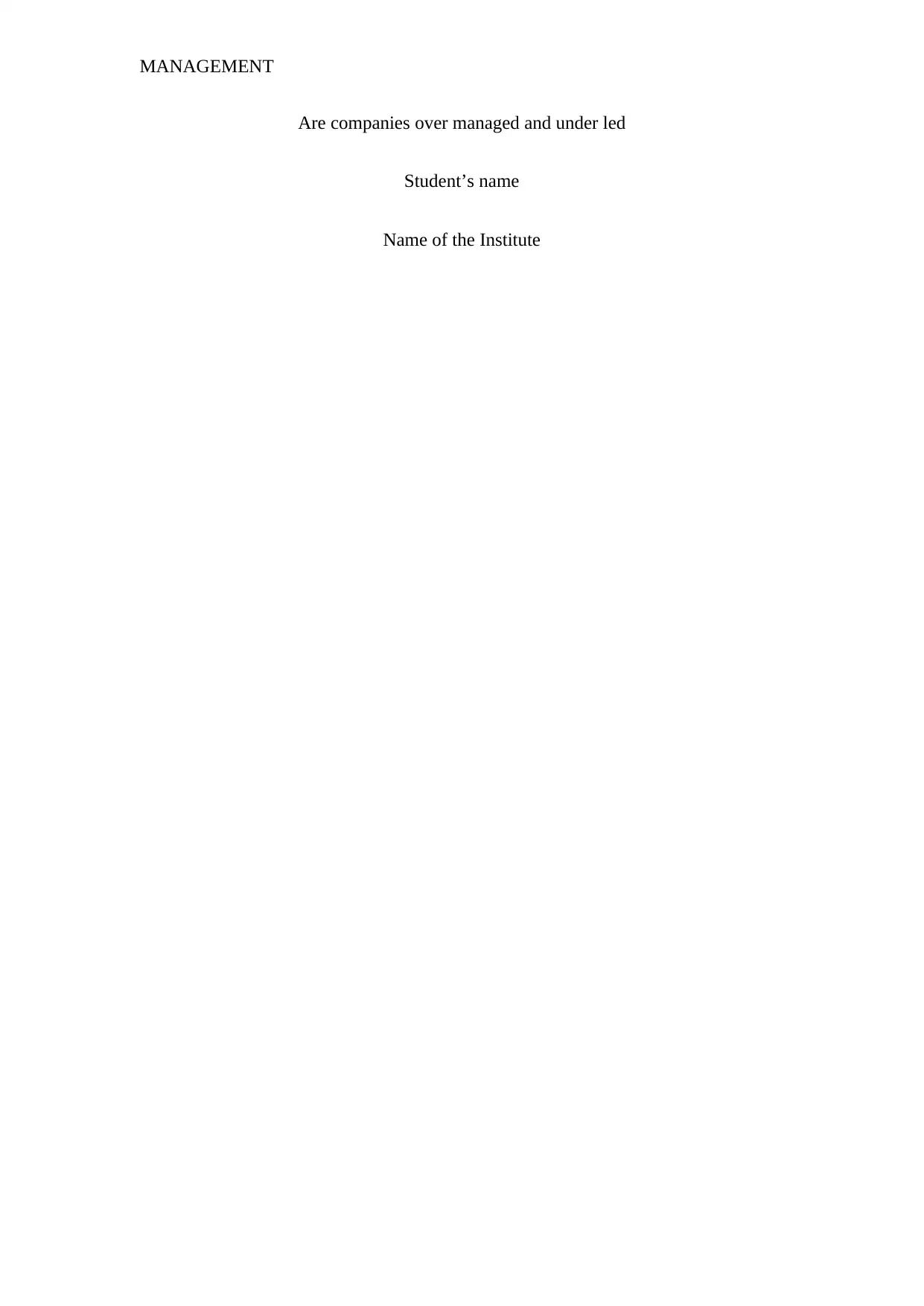
MANAGEMENT
Are companies over managed and under led
Student’s name
Name of the Institute
Are companies over managed and under led
Student’s name
Name of the Institute
Paraphrase This Document
Need a fresh take? Get an instant paraphrase of this document with our AI Paraphraser
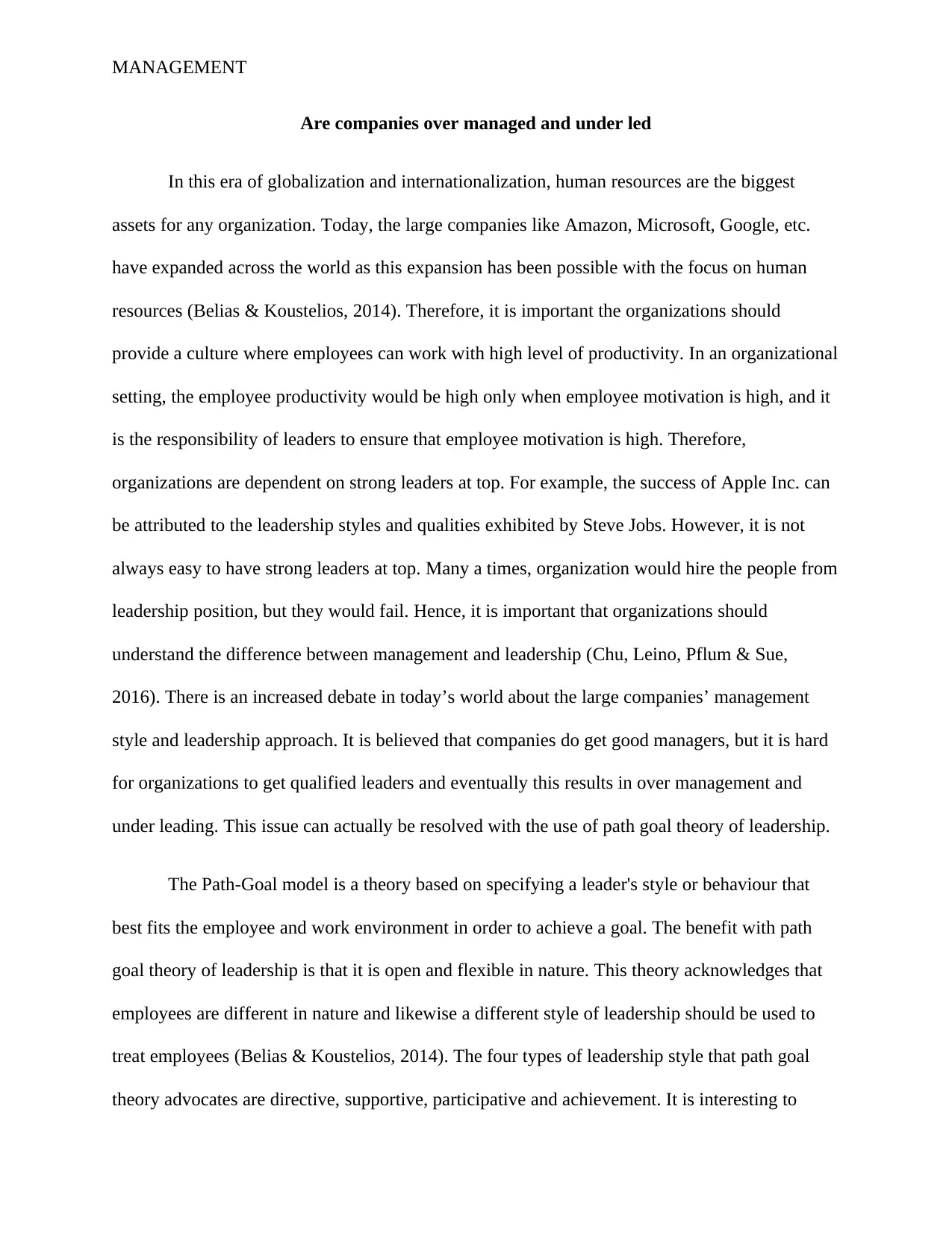
MANAGEMENT
Are companies over managed and under led
In this era of globalization and internationalization, human resources are the biggest
assets for any organization. Today, the large companies like Amazon, Microsoft, Google, etc.
have expanded across the world as this expansion has been possible with the focus on human
resources (Belias & Koustelios, 2014). Therefore, it is important the organizations should
provide a culture where employees can work with high level of productivity. In an organizational
setting, the employee productivity would be high only when employee motivation is high, and it
is the responsibility of leaders to ensure that employee motivation is high. Therefore,
organizations are dependent on strong leaders at top. For example, the success of Apple Inc. can
be attributed to the leadership styles and qualities exhibited by Steve Jobs. However, it is not
always easy to have strong leaders at top. Many a times, organization would hire the people from
leadership position, but they would fail. Hence, it is important that organizations should
understand the difference between management and leadership (Chu, Leino, Pflum & Sue,
2016). There is an increased debate in today’s world about the large companies’ management
style and leadership approach. It is believed that companies do get good managers, but it is hard
for organizations to get qualified leaders and eventually this results in over management and
under leading. This issue can actually be resolved with the use of path goal theory of leadership.
The Path-Goal model is a theory based on specifying a leader's style or behaviour that
best fits the employee and work environment in order to achieve a goal. The benefit with path
goal theory of leadership is that it is open and flexible in nature. This theory acknowledges that
employees are different in nature and likewise a different style of leadership should be used to
treat employees (Belias & Koustelios, 2014). The four types of leadership style that path goal
theory advocates are directive, supportive, participative and achievement. It is interesting to
Are companies over managed and under led
In this era of globalization and internationalization, human resources are the biggest
assets for any organization. Today, the large companies like Amazon, Microsoft, Google, etc.
have expanded across the world as this expansion has been possible with the focus on human
resources (Belias & Koustelios, 2014). Therefore, it is important the organizations should
provide a culture where employees can work with high level of productivity. In an organizational
setting, the employee productivity would be high only when employee motivation is high, and it
is the responsibility of leaders to ensure that employee motivation is high. Therefore,
organizations are dependent on strong leaders at top. For example, the success of Apple Inc. can
be attributed to the leadership styles and qualities exhibited by Steve Jobs. However, it is not
always easy to have strong leaders at top. Many a times, organization would hire the people from
leadership position, but they would fail. Hence, it is important that organizations should
understand the difference between management and leadership (Chu, Leino, Pflum & Sue,
2016). There is an increased debate in today’s world about the large companies’ management
style and leadership approach. It is believed that companies do get good managers, but it is hard
for organizations to get qualified leaders and eventually this results in over management and
under leading. This issue can actually be resolved with the use of path goal theory of leadership.
The Path-Goal model is a theory based on specifying a leader's style or behaviour that
best fits the employee and work environment in order to achieve a goal. The benefit with path
goal theory of leadership is that it is open and flexible in nature. This theory acknowledges that
employees are different in nature and likewise a different style of leadership should be used to
treat employees (Belias & Koustelios, 2014). The four types of leadership style that path goal
theory advocates are directive, supportive, participative and achievement. It is interesting to
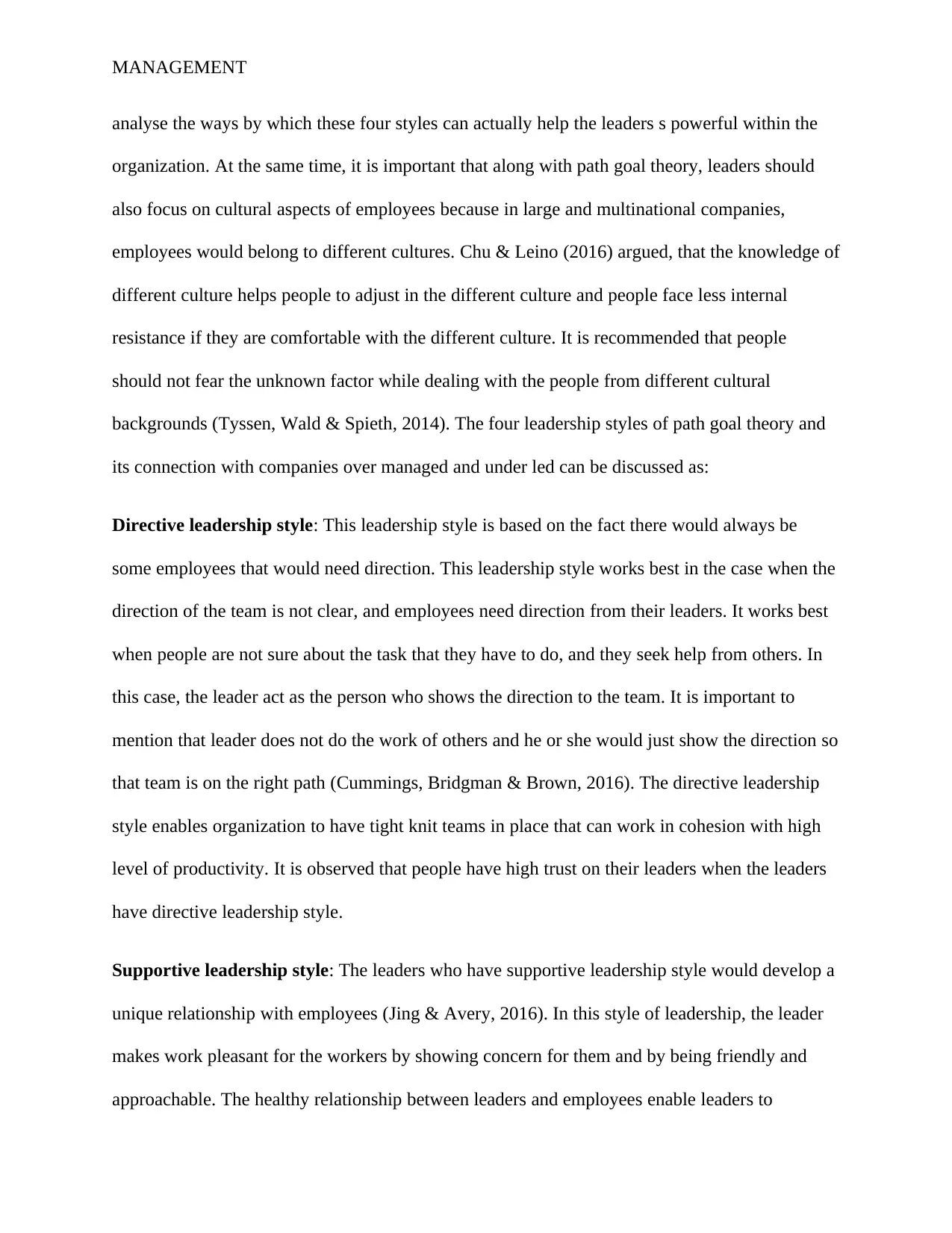
MANAGEMENT
analyse the ways by which these four styles can actually help the leaders s powerful within the
organization. At the same time, it is important that along with path goal theory, leaders should
also focus on cultural aspects of employees because in large and multinational companies,
employees would belong to different cultures. Chu & Leino (2016) argued, that the knowledge of
different culture helps people to adjust in the different culture and people face less internal
resistance if they are comfortable with the different culture. It is recommended that people
should not fear the unknown factor while dealing with the people from different cultural
backgrounds (Tyssen, Wald & Spieth, 2014). The four leadership styles of path goal theory and
its connection with companies over managed and under led can be discussed as:
Directive leadership style: This leadership style is based on the fact there would always be
some employees that would need direction. This leadership style works best in the case when the
direction of the team is not clear, and employees need direction from their leaders. It works best
when people are not sure about the task that they have to do, and they seek help from others. In
this case, the leader act as the person who shows the direction to the team. It is important to
mention that leader does not do the work of others and he or she would just show the direction so
that team is on the right path (Cummings, Bridgman & Brown, 2016). The directive leadership
style enables organization to have tight knit teams in place that can work in cohesion with high
level of productivity. It is observed that people have high trust on their leaders when the leaders
have directive leadership style.
Supportive leadership style: The leaders who have supportive leadership style would develop a
unique relationship with employees (Jing & Avery, 2016). In this style of leadership, the leader
makes work pleasant for the workers by showing concern for them and by being friendly and
approachable. The healthy relationship between leaders and employees enable leaders to
analyse the ways by which these four styles can actually help the leaders s powerful within the
organization. At the same time, it is important that along with path goal theory, leaders should
also focus on cultural aspects of employees because in large and multinational companies,
employees would belong to different cultures. Chu & Leino (2016) argued, that the knowledge of
different culture helps people to adjust in the different culture and people face less internal
resistance if they are comfortable with the different culture. It is recommended that people
should not fear the unknown factor while dealing with the people from different cultural
backgrounds (Tyssen, Wald & Spieth, 2014). The four leadership styles of path goal theory and
its connection with companies over managed and under led can be discussed as:
Directive leadership style: This leadership style is based on the fact there would always be
some employees that would need direction. This leadership style works best in the case when the
direction of the team is not clear, and employees need direction from their leaders. It works best
when people are not sure about the task that they have to do, and they seek help from others. In
this case, the leader act as the person who shows the direction to the team. It is important to
mention that leader does not do the work of others and he or she would just show the direction so
that team is on the right path (Cummings, Bridgman & Brown, 2016). The directive leadership
style enables organization to have tight knit teams in place that can work in cohesion with high
level of productivity. It is observed that people have high trust on their leaders when the leaders
have directive leadership style.
Supportive leadership style: The leaders who have supportive leadership style would develop a
unique relationship with employees (Jing & Avery, 2016). In this style of leadership, the leader
makes work pleasant for the workers by showing concern for them and by being friendly and
approachable. The healthy relationship between leaders and employees enable leaders to
⊘ This is a preview!⊘
Do you want full access?
Subscribe today to unlock all pages.

Trusted by 1+ million students worldwide
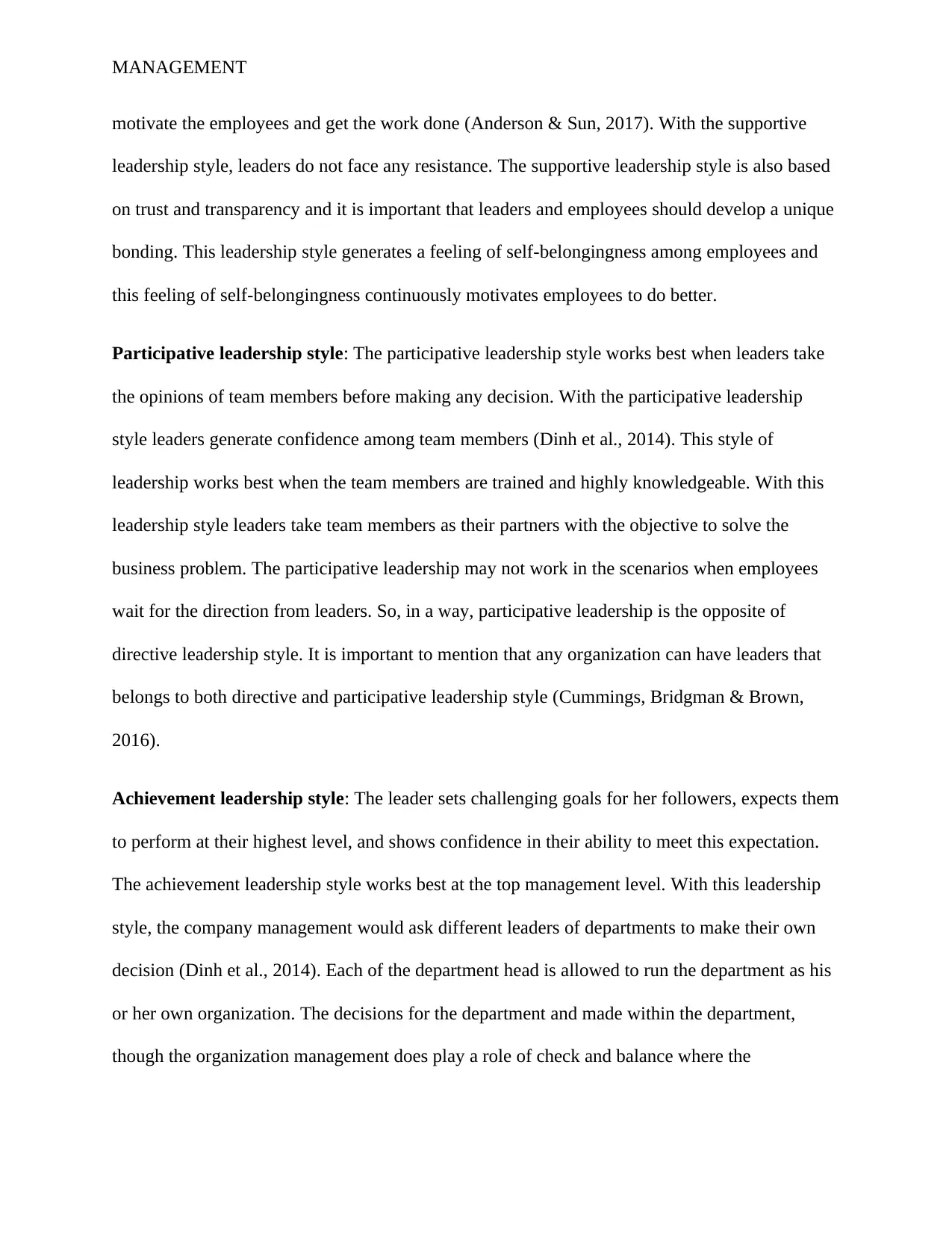
MANAGEMENT
motivate the employees and get the work done (Anderson & Sun, 2017). With the supportive
leadership style, leaders do not face any resistance. The supportive leadership style is also based
on trust and transparency and it is important that leaders and employees should develop a unique
bonding. This leadership style generates a feeling of self-belongingness among employees and
this feeling of self-belongingness continuously motivates employees to do better.
Participative leadership style: The participative leadership style works best when leaders take
the opinions of team members before making any decision. With the participative leadership
style leaders generate confidence among team members (Dinh et al., 2014). This style of
leadership works best when the team members are trained and highly knowledgeable. With this
leadership style leaders take team members as their partners with the objective to solve the
business problem. The participative leadership may not work in the scenarios when employees
wait for the direction from leaders. So, in a way, participative leadership is the opposite of
directive leadership style. It is important to mention that any organization can have leaders that
belongs to both directive and participative leadership style (Cummings, Bridgman & Brown,
2016).
Achievement leadership style: The leader sets challenging goals for her followers, expects them
to perform at their highest level, and shows confidence in their ability to meet this expectation.
The achievement leadership style works best at the top management level. With this leadership
style, the company management would ask different leaders of departments to make their own
decision (Dinh et al., 2014). Each of the department head is allowed to run the department as his
or her own organization. The decisions for the department and made within the department,
though the organization management does play a role of check and balance where the
motivate the employees and get the work done (Anderson & Sun, 2017). With the supportive
leadership style, leaders do not face any resistance. The supportive leadership style is also based
on trust and transparency and it is important that leaders and employees should develop a unique
bonding. This leadership style generates a feeling of self-belongingness among employees and
this feeling of self-belongingness continuously motivates employees to do better.
Participative leadership style: The participative leadership style works best when leaders take
the opinions of team members before making any decision. With the participative leadership
style leaders generate confidence among team members (Dinh et al., 2014). This style of
leadership works best when the team members are trained and highly knowledgeable. With this
leadership style leaders take team members as their partners with the objective to solve the
business problem. The participative leadership may not work in the scenarios when employees
wait for the direction from leaders. So, in a way, participative leadership is the opposite of
directive leadership style. It is important to mention that any organization can have leaders that
belongs to both directive and participative leadership style (Cummings, Bridgman & Brown,
2016).
Achievement leadership style: The leader sets challenging goals for her followers, expects them
to perform at their highest level, and shows confidence in their ability to meet this expectation.
The achievement leadership style works best at the top management level. With this leadership
style, the company management would ask different leaders of departments to make their own
decision (Dinh et al., 2014). Each of the department head is allowed to run the department as his
or her own organization. The decisions for the department and made within the department,
though the organization management does play a role of check and balance where the
Paraphrase This Document
Need a fresh take? Get an instant paraphrase of this document with our AI Paraphraser
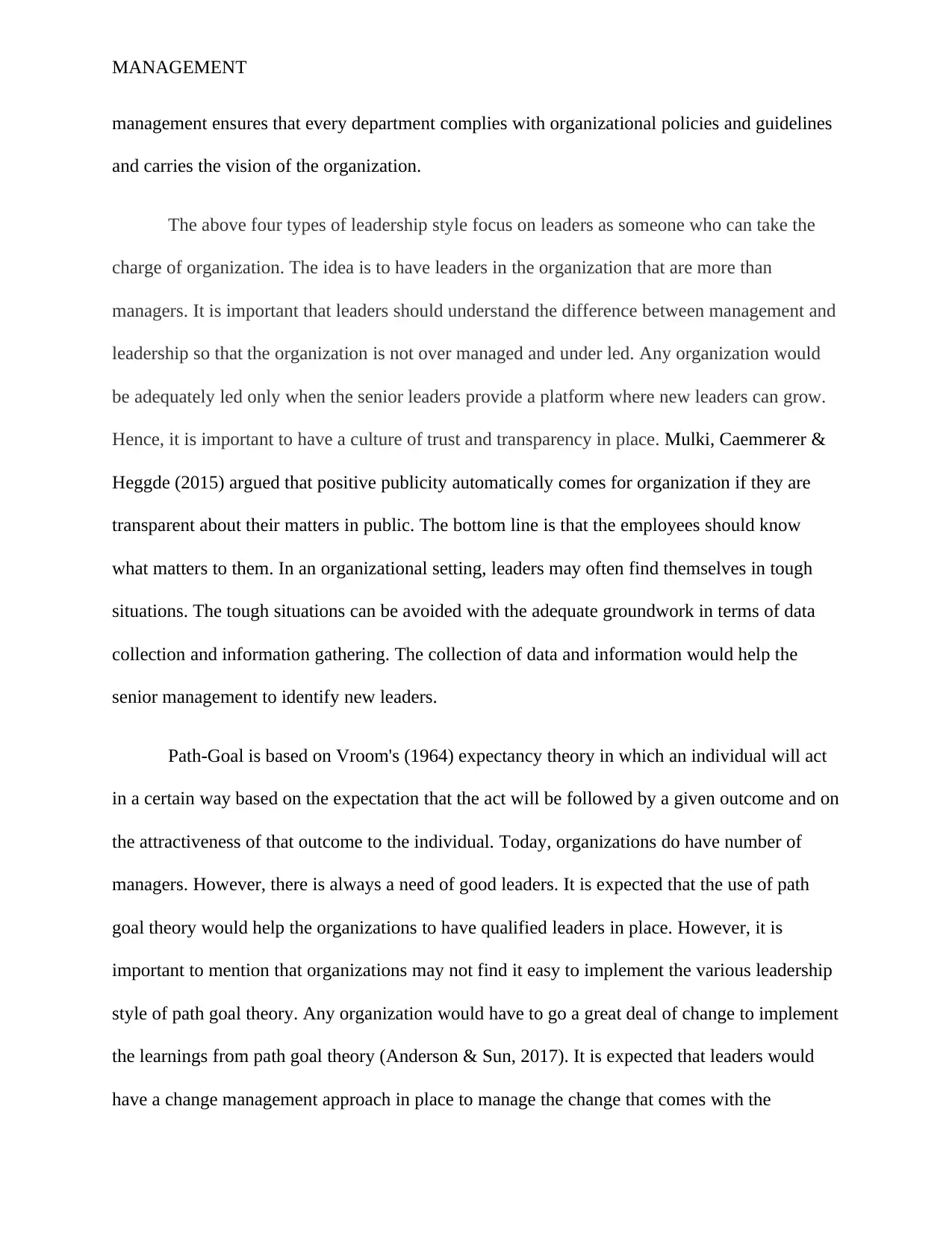
MANAGEMENT
management ensures that every department complies with organizational policies and guidelines
and carries the vision of the organization.
The above four types of leadership style focus on leaders as someone who can take the
charge of organization. The idea is to have leaders in the organization that are more than
managers. It is important that leaders should understand the difference between management and
leadership so that the organization is not over managed and under led. Any organization would
be adequately led only when the senior leaders provide a platform where new leaders can grow.
Hence, it is important to have a culture of trust and transparency in place. Mulki, Caemmerer &
Heggde (2015) argued that positive publicity automatically comes for organization if they are
transparent about their matters in public. The bottom line is that the employees should know
what matters to them. In an organizational setting, leaders may often find themselves in tough
situations. The tough situations can be avoided with the adequate groundwork in terms of data
collection and information gathering. The collection of data and information would help the
senior management to identify new leaders.
Path-Goal is based on Vroom's (1964) expectancy theory in which an individual will act
in a certain way based on the expectation that the act will be followed by a given outcome and on
the attractiveness of that outcome to the individual. Today, organizations do have number of
managers. However, there is always a need of good leaders. It is expected that the use of path
goal theory would help the organizations to have qualified leaders in place. However, it is
important to mention that organizations may not find it easy to implement the various leadership
style of path goal theory. Any organization would have to go a great deal of change to implement
the learnings from path goal theory (Anderson & Sun, 2017). It is expected that leaders would
have a change management approach in place to manage the change that comes with the
management ensures that every department complies with organizational policies and guidelines
and carries the vision of the organization.
The above four types of leadership style focus on leaders as someone who can take the
charge of organization. The idea is to have leaders in the organization that are more than
managers. It is important that leaders should understand the difference between management and
leadership so that the organization is not over managed and under led. Any organization would
be adequately led only when the senior leaders provide a platform where new leaders can grow.
Hence, it is important to have a culture of trust and transparency in place. Mulki, Caemmerer &
Heggde (2015) argued that positive publicity automatically comes for organization if they are
transparent about their matters in public. The bottom line is that the employees should know
what matters to them. In an organizational setting, leaders may often find themselves in tough
situations. The tough situations can be avoided with the adequate groundwork in terms of data
collection and information gathering. The collection of data and information would help the
senior management to identify new leaders.
Path-Goal is based on Vroom's (1964) expectancy theory in which an individual will act
in a certain way based on the expectation that the act will be followed by a given outcome and on
the attractiveness of that outcome to the individual. Today, organizations do have number of
managers. However, there is always a need of good leaders. It is expected that the use of path
goal theory would help the organizations to have qualified leaders in place. However, it is
important to mention that organizations may not find it easy to implement the various leadership
style of path goal theory. Any organization would have to go a great deal of change to implement
the learnings from path goal theory (Anderson & Sun, 2017). It is expected that leaders would
have a change management approach in place to manage the change that comes with the
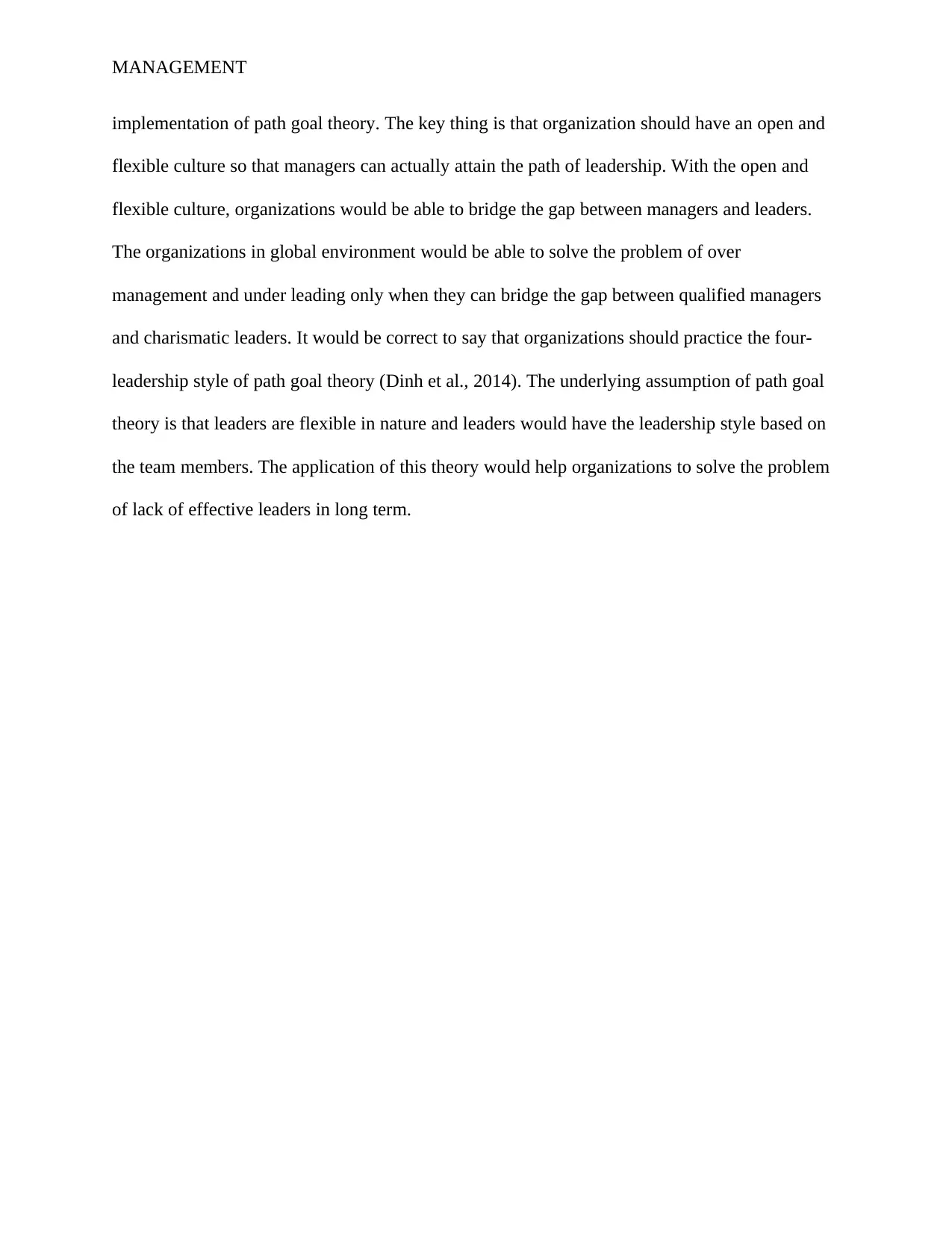
MANAGEMENT
implementation of path goal theory. The key thing is that organization should have an open and
flexible culture so that managers can actually attain the path of leadership. With the open and
flexible culture, organizations would be able to bridge the gap between managers and leaders.
The organizations in global environment would be able to solve the problem of over
management and under leading only when they can bridge the gap between qualified managers
and charismatic leaders. It would be correct to say that organizations should practice the four-
leadership style of path goal theory (Dinh et al., 2014). The underlying assumption of path goal
theory is that leaders are flexible in nature and leaders would have the leadership style based on
the team members. The application of this theory would help organizations to solve the problem
of lack of effective leaders in long term.
implementation of path goal theory. The key thing is that organization should have an open and
flexible culture so that managers can actually attain the path of leadership. With the open and
flexible culture, organizations would be able to bridge the gap between managers and leaders.
The organizations in global environment would be able to solve the problem of over
management and under leading only when they can bridge the gap between qualified managers
and charismatic leaders. It would be correct to say that organizations should practice the four-
leadership style of path goal theory (Dinh et al., 2014). The underlying assumption of path goal
theory is that leaders are flexible in nature and leaders would have the leadership style based on
the team members. The application of this theory would help organizations to solve the problem
of lack of effective leaders in long term.
⊘ This is a preview!⊘
Do you want full access?
Subscribe today to unlock all pages.

Trusted by 1+ million students worldwide
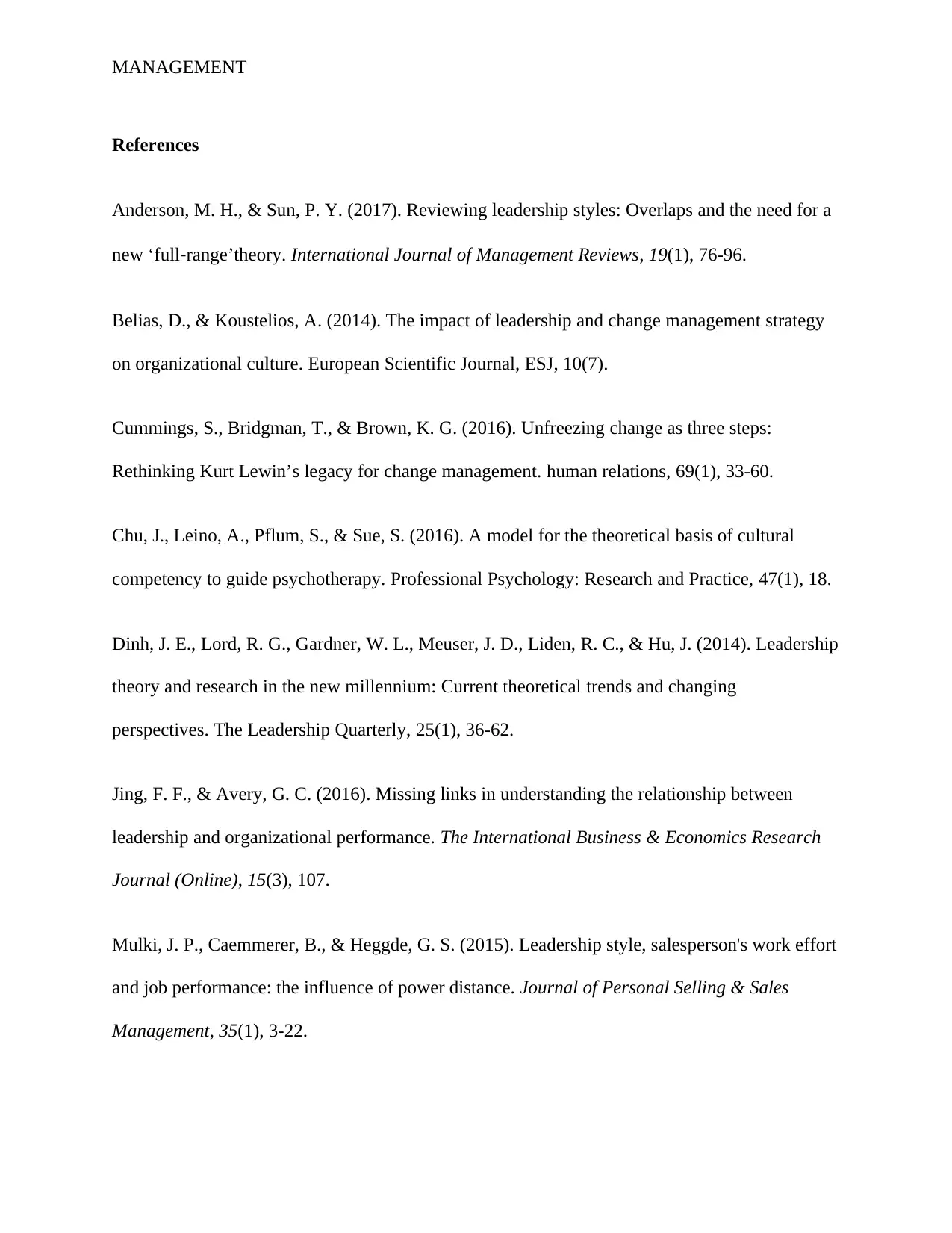
MANAGEMENT
References
Anderson, M. H., & Sun, P. Y. (2017). Reviewing leadership styles: Overlaps and the need for a
new ‘full‐range’theory. International Journal of Management Reviews, 19(1), 76-96.
Belias, D., & Koustelios, A. (2014). The impact of leadership and change management strategy
on organizational culture. European Scientific Journal, ESJ, 10(7).
Cummings, S., Bridgman, T., & Brown, K. G. (2016). Unfreezing change as three steps:
Rethinking Kurt Lewin’s legacy for change management. human relations, 69(1), 33-60.
Chu, J., Leino, A., Pflum, S., & Sue, S. (2016). A model for the theoretical basis of cultural
competency to guide psychotherapy. Professional Psychology: Research and Practice, 47(1), 18.
Dinh, J. E., Lord, R. G., Gardner, W. L., Meuser, J. D., Liden, R. C., & Hu, J. (2014). Leadership
theory and research in the new millennium: Current theoretical trends and changing
perspectives. The Leadership Quarterly, 25(1), 36-62.
Jing, F. F., & Avery, G. C. (2016). Missing links in understanding the relationship between
leadership and organizational performance. The International Business & Economics Research
Journal (Online), 15(3), 107.
Mulki, J. P., Caemmerer, B., & Heggde, G. S. (2015). Leadership style, salesperson's work effort
and job performance: the influence of power distance. Journal of Personal Selling & Sales
Management, 35(1), 3-22.
References
Anderson, M. H., & Sun, P. Y. (2017). Reviewing leadership styles: Overlaps and the need for a
new ‘full‐range’theory. International Journal of Management Reviews, 19(1), 76-96.
Belias, D., & Koustelios, A. (2014). The impact of leadership and change management strategy
on organizational culture. European Scientific Journal, ESJ, 10(7).
Cummings, S., Bridgman, T., & Brown, K. G. (2016). Unfreezing change as three steps:
Rethinking Kurt Lewin’s legacy for change management. human relations, 69(1), 33-60.
Chu, J., Leino, A., Pflum, S., & Sue, S. (2016). A model for the theoretical basis of cultural
competency to guide psychotherapy. Professional Psychology: Research and Practice, 47(1), 18.
Dinh, J. E., Lord, R. G., Gardner, W. L., Meuser, J. D., Liden, R. C., & Hu, J. (2014). Leadership
theory and research in the new millennium: Current theoretical trends and changing
perspectives. The Leadership Quarterly, 25(1), 36-62.
Jing, F. F., & Avery, G. C. (2016). Missing links in understanding the relationship between
leadership and organizational performance. The International Business & Economics Research
Journal (Online), 15(3), 107.
Mulki, J. P., Caemmerer, B., & Heggde, G. S. (2015). Leadership style, salesperson's work effort
and job performance: the influence of power distance. Journal of Personal Selling & Sales
Management, 35(1), 3-22.
Paraphrase This Document
Need a fresh take? Get an instant paraphrase of this document with our AI Paraphraser
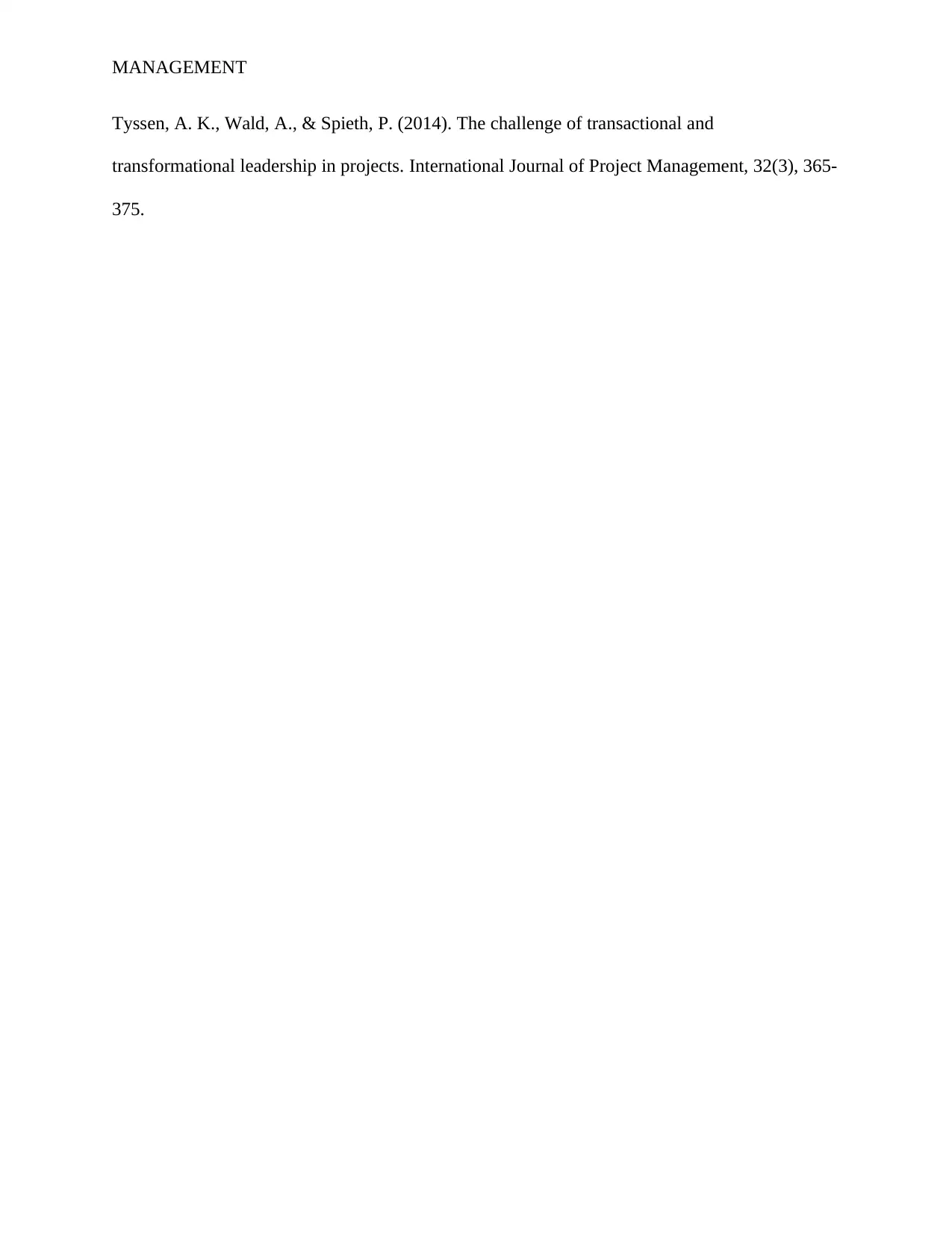
MANAGEMENT
Tyssen, A. K., Wald, A., & Spieth, P. (2014). The challenge of transactional and
transformational leadership in projects. International Journal of Project Management, 32(3), 365-
375.
Tyssen, A. K., Wald, A., & Spieth, P. (2014). The challenge of transactional and
transformational leadership in projects. International Journal of Project Management, 32(3), 365-
375.
1 out of 8
Related Documents
Your All-in-One AI-Powered Toolkit for Academic Success.
+13062052269
info@desklib.com
Available 24*7 on WhatsApp / Email
![[object Object]](/_next/static/media/star-bottom.7253800d.svg)
Unlock your academic potential
Copyright © 2020–2025 A2Z Services. All Rights Reserved. Developed and managed by ZUCOL.




